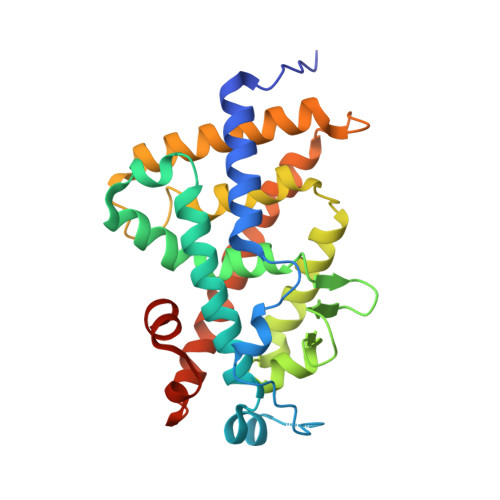Synthesis of novel C-2 substituted vitamin D derivatives having ringed side chains and their biological evaluation on bone
Saito, H., Takagi, K., Horie, K., Kakuda, S., Takimoto-Kamimura, M., Ochiai, E., Chida, T., Harada, Y., Takenouchi, K., Kittaka, A.(2013) J Steroid Biochem Mol Biol 136: 3-8
- PubMed: 23416104
- DOI: https://doi.org/10.1016/j.jsbmb.2013.02.004
- Primary Citation of Related Structures:
3VHW - PubMed Abstract:
Up to the present, numerous vitamin D derivatives have been synthesized, but most of them have straight side chains, and there are few publications described about in vitro and in vivo evaluations on bone by vitamin D derivatives. In our previous paper, we reported the synthesis of various C-2 substituted vitamin D derivatives (2b-2i) with a 2,2-dimethylcyclopentanone unit in the CD-ring side chains, and that the derivatives have strong activity for enhancing bone growth. On the basis of results, this time, we report the synthesis of 2α-substituted vitamin D3 derivatives with chiral cyclopentanone (3-6 and 12-16). These derivatives were obtained by Pd-coupling reaction with A-ring precursor and CD-rings precursor. We evaluated novel derivatives in vitro assays, for affinities for VDR and transactivation assays by human osteosarcoma (HOS) cells. In this research, we demonstrated that some novel vitamin D derivatives (12-MP, 13-MP, 15-MP and 16-LP) have strong transactivation activities in spite of lower affinity for VDR than 1. In addition, we also demonstrated that these derivatives have strong activities for enhancing bone growth using OVX therapeutic rats. This article is part of a Special Issue entitled 'Vitamin D Workshop'.
Organizational Affiliation:
Teijin Institute for Bio-medical Research, Teijin Pharma Ltd., Tokyo 191-8512, Japan. hi.saitou@teijin.co.jp















